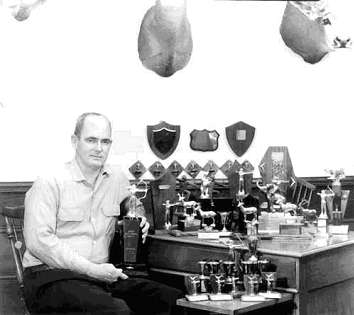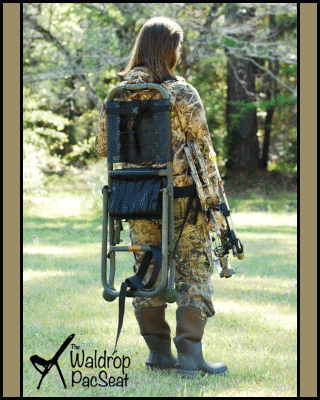"It" Can an Be Licked! By Jack Howard
(from the December, 1962 issue of Archery Magazine)
Foreword: The author of this piece is well known to the old timers out there. His successes in the field of hunting are the stuff of legends.
In this article from 1962 he explains a method of combating "IT"... a common term applied to what is now called target panic.
For those of you experiencing the problems listed in the article, it is a good method of beating an age old archer's nemesis.
Good shooting,
Charlie Lamb 
There has been much said about "It" as of late. As I had been afflicted with a case of this dreaded archery affliction and have been able to lick it, I wish to pass my method on to you.
Although most cases of "IT" are the same, what is good for the goose is not always good for the gander. But if I can help a few of you I will be greatly pleased.
As has been stated by others, "IT" is defined as involuntary actions of the archer, or, to put it very simply, when all is just right for you to release your arrow, you come completely unglued. There are different stages of "IT", but the end result is always the same- poor shooting.
Why does a person freeze off the target? This is caused by the subconscious fear of blowing up when the sight falls on the bulls-eye, or if you shoot instinctively, it's when your bow arm is exactly where you want it. The proof of this is the fact that we have no problem holding on the target without an arrow in our bow when we know we are not going to shoot.
Where one person suffering from "IT" freezes off the target, the next may be able to get on the target by some gimmick such as counting or blurring his vision, but when the time comes to shoot, "IT" strikes. Compared with "IT" the mechanical troubles of shooting are infinately small.
Before I tell you my method of licking this malady I would like to give you a little of my case history.Before 1950 I was in the process of developing my shooting technique. Between 1950 and 1953 I was considered by many as one of the nation's top free-style roving archers. My field scores seldom were below 850, and occasionally over 900. Then I was struck by that dreaded archer's disease, "IT".
"IT" started slowly deteriorating my shooting. It was not long before the novice archers were beginning to tell me how to improve my shooting. This, of course, hurt right down to the core, but I listened politely although my thoughts were along the line of "drop dead!"
My scores dropped down to a low of 600. A score of 600 may or may not sound low to many of you, but a person's let-down is measured by what he is used to shooting and what he feels he is capable of.
I continued to receive all the help I could use from the novice archers, and I finally reached the point where even the thought of holding my sight on the bulls-eye could make me break out in a cold sweat. My ego was deflated as flat as a pancake. Finally the humiliation and my embarrassment became so unbearable I became a recluse, shooting on my own private bale only. My shooting morale was at rock bottom, but I did not give up, as my love of bowhunting would not permit this.
At that time I did not know what my trouble was. "IT", although present among archers at that time, never was discussed openly. I had no one to give me any advice on what my real problem was, only the unknowing archers were more than willing to tell me all the things I was doing wrong. These things were really caused by the result of "IT". I was determined to lick my problem, and I had to start out from scratch.
I tried everything under the sun, far too many thing to possibly mention here. Many of the things I'm sure would be considered as ridiculous by most of you. One method, for instance, was where I aimed, closed my eyes for the count of two, and then shot, worked fairly well, too.
Many of the things I tried started off as if my problems were all over, but proved only to be a temporary gimmick. After trying everything I could think of, and analyzing the results, I began to realize more about the real cause of my problem. As "IT" had not been discussed openly, I did not know that "IT" was my trouble. I spent two years just trying to correct things which were caused by "IT". For example: I reasoned that my 46-lb. practice bow was too heavy, and this was why I could not hold steady on the bulls-eye. So I tried a 35-lb. bow. No dice. I still couldn't hold steady on the bulls-eye. I soon began to realize that all the problems I had gone through- freezing, snap-shooting, can't come to full draw, can't touch anchor point, dropping bow arm badly, exploding realease, etc., etc.- were caused from the fact I could not hold my sight on the bulls-eye and coordinate. Sounds simple, doesn't it? At that time this was new to me.
I decided that all the gimmicks I had been trying were just a waste of time, as they all proved to be just a temporary help. Just as I had become accustomed to a new gimmick to help me hold on the target, I would fall flat on my face. I'm sure the reason that a new gimmick always starts out seemingly helpful, is that your concentration is transferred away from your problem temporarily. As soon as you get used to the gimmick, back comes the problem. I had to face up to the fact that there was just no other way. I would have to learn how to hold my sight on the target.
Although I had reached the point where I could not hold my sight on the bulls-eye with an arrow in my bow, I could draw back and hold perfectly without one. I did know one thing for sure, and that was , doing the same thing over and over becomes a habit. With this knowledge in mind, I started practicing pulling my bow and holding my sight on the target without an arrow in the bow. Soon I could pull my bow and hold perfectly WITH an arrow in my bow.
After practicing this dry-run method for a while I worked out a system where I had one dry-run and then shot one arrow. After practicing this a number of months I was able to shoot a perfect arrow rather often. If I flubbed a shot, I would have two or three more dry-runs before I tried to shoot another arrow. After some time I was able to shoot two or three perfect arrows before I had to revert to a dry-run.
I would like to point out that many times you will start to come apart on a shot you figured was going to be a good one. When this happens , don't shoot, but go into a dry run and hold on the target for two or three seconds and then let down. It should be kept in mind that the reason for this type of practice is to become accustomed to seeing your sight on the bulls-eye or in the case of the instinctive shooter, his gap or tip of arrow.
This should eventually become so much a habit, that the fact that your aim is right where you want it will not shake you up in any way.
After a year of this method of practicing I was able to start shooting in field tournaments again, but when I did , I continued with my same method as I used in practice. When I started to come unglued on a shot I would change to a dry-run, hold and then let down. As to not embarrass myself by my seemingly peculiar actions I would usually explain to the group with whom I was shooting that I had no particular interest in my score, and that my only interest was in shooting as many good arrows as I could.
The first year after starting my tournament shooting again, I had worked my way up to the top man in my club. My field scores were as good as they had ever been.and I now could occasionally break 900. In all, I spent approximately four years to regain my original standing from the time I had been struck by "IT". Two years of which were just in finding out that "IT" was my problem.
The fact that"IT" has been so much talked about lately should be a tremendous help to the archer afflicted with this disease. The archers who do have "IT" will realize they are not alone, which is a big help in itself. The archers who do not have this trouble may learn that in order to really help their buddies that they best keep their mouths shut when in a tournament. If any talk is being done, it should not be done on a tournament day. Any attempted help to a person who is suffering with "IT" on a tournament day will only be detrimental and persons giving said help will just be another cog in the wheel which eventually may lead to the archer giving up the game.
Which brings to mind a few do's and don'ts. Don't expect to lick "IT" in tournaments alone, as this cannot be done. Your best practice toward licking "IT" is completely by yourself. This way you can completely concentrate on your shooting, and there will be nothing to distract from your attention. Do practice at least one-half hour every other day. If you are afflicted by "IT", don't be too concerned about score in tournament shooting until you have "IT" licked. Don't expect to lick "IT" over night. Do keep in mind that the reason for dry-runs is to form a habit of holding on the bulls-eye without getting "all shook up".
"IT" can also affect a person's hunting success. Not so much that a person has a case of "IT" while shooting at game, but by the result of not wanting to do any practicing because of "IT". I have heard many a fellow say, "I can't shoot at a target, I hate shooting at targets. Game is the only thing I want to shoot at." If I had that attitude, my game take would be at least 50% less than what it is.
I have told you how I overcame "IT". I know of no easy way to combat this archery malady. For some of you I'm sure this method will work if you have the determination to stick with it. For the rest, my information may not be worth a hill of beans. But I expect soon there will be other fellows with their methods of combating this problem and with enough methods maybe we can eventually cure this affliction.




















